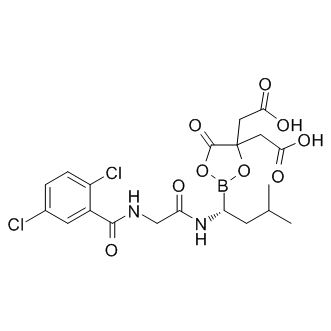| Cas No.: | 1239908-20-3 |
| Chemical Name: | Ixazomib citrate |
| Synonyms: | MLN9708; MLN-9708; MLN 9708; ixazomib citrate. MMLN-2238-prodrug. MMLN 2238-prodrug; MMLN2238-prodrug; Ixazomib-prodrug; Ninlaro. |
| SMILES: | B1(OC(=O)CC(O1)(CC(=O)O)C(=O)O)[C@H](CC(C)C)NC(=O)CNC(=O)C2=C(C=CC(=C2)Cl)Cl |
| Formula: | C20H23BCl2N2O9 |
| M.Wt: | 517.122 |
| Sotrage: | 2 years -20°C Powder, 2 weeks 4°C in DMSO, 6 months -80°C in DMSO |
| Description: | Ixazomib citrate (MLN9708) is a reversible inhibitor of the chymotrypsin-like proteolytic β5 site of the 20S proteasome with an IC50 of 3.4 nM and a Ki of 0.93 nM. |
| In Vivo: | Ixazomib citrate (MLN9708; 11 mg/kg) significantly inhibits MM tumor growth and prolongs survival in the human plasmacytoma MM.1S xenograft mouse model. The blood chemistry profiles of Ixazomib-treated mice show normal levels of creatinine, hemoglobin, and bilirubin. Ixazomib dramatically increases the number of cleaved-caspase-3 positive cells of the xenograft model[2]. |
| In Vitro: | Ixazomib citrate (MLN9708; 0.20-3.20 µM) inhibits the cell growth of both cell lines effectively in a time- and dose-dependent manner. Ixazomib induces cell cycle arrest in MG-63 and Saos-2 cells. Ixazomib induces apoptosis mainly through the caspases pathway and requires the activation of both caspase8 and caspase9. Ixazomib treatment increases the levels of pro-apoptotic proteins and down regulates the anti-apoptotic proteins that control MOMP. Ixazomib treatment induces the release of Cytc, Smac, OMI from mitochondria and decreases the protein levels of XIAP. Ixazomib inhibits the invasion ability of MG-63 and Saos-2 cells and decreases both the expression and secretion levels of MMP2/9[1].Ixazomib citrate (MLN9708; 12 nM) shows inhibitory activity against C-L and T-L proteasome activities. Treatment of H929 and MM.1S MM cells with Ixazomib triggers a marked increase in proteolytic cleavage of poly(ADP) ribose polymerase (PARP), a signature event during apoptosis. Ixazomib induces cleavage of caspase-3, an upstream activator of PARP. Ixazomib induces eIf2-α kinase activity and protein levels of Bip and CHOP/GADD153. Ixazomib blocks BMSCs-induced MM cell proliferation, inhibits in vitro capillary tubule formation, and target NF-κB[2]. |

 DC Chemicals' products qualify for U.S. tariff exemptions. We guarantee no price increases due to customs duties and maintain stable supply, continuing to deliver reliable research solutions to our American clients.
DC Chemicals' products qualify for U.S. tariff exemptions. We guarantee no price increases due to customs duties and maintain stable supply, continuing to deliver reliable research solutions to our American clients.





















